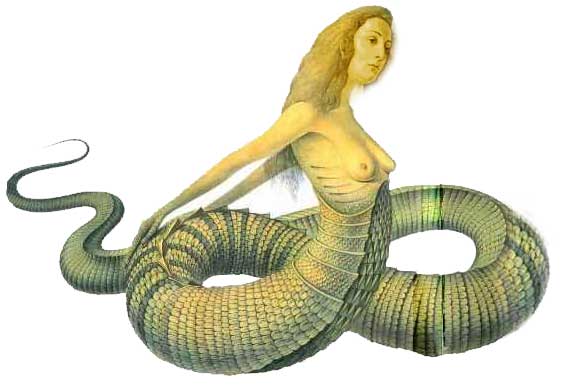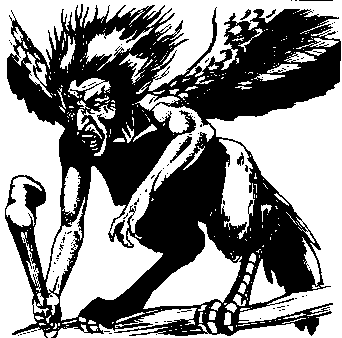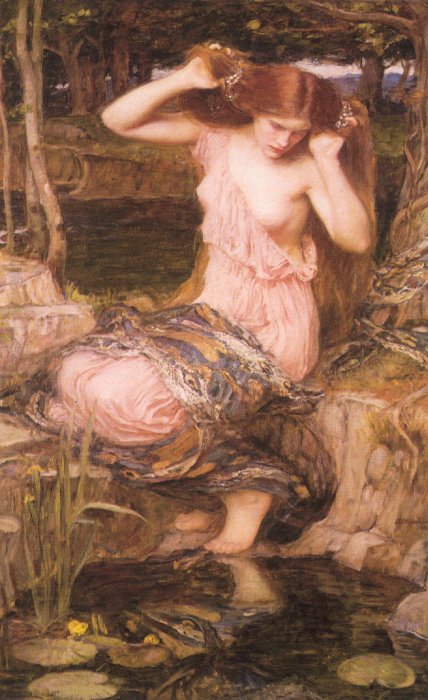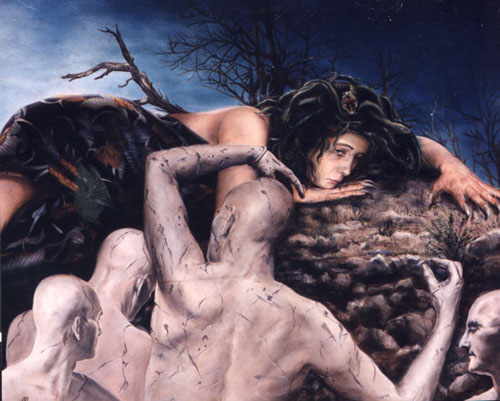Monstresses and Monstrosities
List of Monsters | Which Monster Are You Quiz | Heracles' 12 Labors | More Monster Pictures

- Brize
- Brize was the Gadfly Hera sent after Io to torment her. This gadfly was the size of a sparrow with a stinger as big as a dagger. Hermes, who eventually was sent by Zeus to save the poor girl (or cow) killed the gadfly. If you want to know more, check out the Myth Pages. In case you didn't figure it out, Brize means Gadfly.
- Campe
- Campe was the jailoress in Tartarus who guarded the Cyclopes and the Hecatoncheires (the Giants). She was double-shaped, and female to her hips. From her chest to her thighs she was covered in fish scales. Over her shoulders a scorpion curled around itself. She was killed by Zeus when he freed the Cyclopes and the Giants to fight the Titans. Campe means "Crooked".

- Charybdis
- Charybdis was once a nymph, the daughter of Poseidon and Gaia. And she flooded lands for her father's underwater kingdom until Zeus turned her into a monster (for stealing and eating some of Heracles' sheep - well, they were really Geryon's sheep, check it out in the Myth Pages) and had her suck in and out water three times an day. She lived in a cave on the Sicilian side of the Strait of Messina, opposite the monster Scylla (see below), the two of them forming a dangerous threat to passing ships. She probably explained a whirlpool. Odysseus managed to avoid Charybdis in the Odyssey. This is great: Charybdis literally means "sucker down".

- Chimaera
- The Chimaera was one part lion to one part goat to one part snake/dragon, and even though we're relatively comfortable with her looks, her parentage is under question. Homer asserts that she was bred by some dude named Amisodarus, but for once I'm gonna go with Hesiod, who says she was one of the many children of Echidna (see below) and Typhon. There are different versions of how these animals were put together to create her, so whatever your imagination says is probably right. As she was like super-monster, she was having a pretty good life just wandering the countryside, killing sheep every once in a while - and there wasn't gonna be anyone who tried to stop her - did I mention that she breathed fire? Yeah, that, too. But this one chick, Sthenoboea, caused all this drama, and made one dude try to kill this other heroic-type dude, named Bellerophon. Wait, you're thinking, what about Chimaera? Well, Dude Number One thought that the best way to get away with killing Dude Two (Bellerophon) would be to insist he go against (ie, kill) the terrible monster that was ravaging the countryside. Turns out our chica wasn't a match for the heroic Bellerophon (who, by the way, was riding the flying horse, Pegasus, that sprang out of the dead Medusa's body - read more about Medusa below). The hero had a lead spear, which wasn't too effective against Chimaera until he stopped trying to use the pointy aspect of it. Instead, he jammed it down her throat, and her fiery breath melted the lead which poured into her stomach and killed her. Alternatively, he just shot her with an arrow from far away, but I think the first version is better.
- Delphyne
- Delphyne was a female dragon. A "half-bestial maiden," as Carlos Parada puts it, who guarded the sinews of the hands and feet of Zeus after her brother Typhon severed them. With the help of Pan's screaming and Hermes' quick fingers, Zeus recovered his tendons. She was eventually killed by Apollo when he took over Delphi (where she guarded a fountain by the oracle). The word Delphyne means Womb. Hmmmmm. This couldn't possibly be an earlier version of Python as the chthonic goddess at Delphi before the patriarchy took over now could it? Nah.
- Echidna
 Echidna was called the mother of all monsters, but really she was only the mother of about six of them: the dragon that guarded the Golden Apples of Hesperos, the Hydra (the many-headed dragon/serpent), the Chimaera (see above), Orthus (a hell-dog), and Cerberus (a more famous hell-dog with three heads), the Crommyonian Sow, the Caucasus Eagle (that's the one that kept eating Prometheus' liver every day), and by her son Orthus she mothered the Sphinx (see below) and the Nemean Lion. Some people also say Scylla and the Gorgons (see below for both) were her kids, but I think they have other more likely parents. She was definitely a scary monster, half-woman half-snake, and she lived with her mate Typhon (the monster who challenged all of the Greek Gods, and ended up with Mt. Aetna thrown on top of him) in a cave in Scythia. Echidna was either the daughter of Callirrhoe and Chrysaor, the Gold Bearer, who was a son of Poseidon and Medusa (see Medusa below), or Styx and Peiras, or (as I prefer) Gaia and Tartarus. Echidna means She-Viper. There's one bizarre story that Heracles paid her a visit when Typhon wasn't home and they had a fling that produced these three future kings (apparently, they inherited none of their mother's monster genes). Another story says that she went to the Peloponnesus to harrass (eat?) travelers, and was there killed by Argus - but she was supposed to be immortal, so I don't really know how that worked. Echidna was called the mother of all monsters, but really she was only the mother of about six of them: the dragon that guarded the Golden Apples of Hesperos, the Hydra (the many-headed dragon/serpent), the Chimaera (see above), Orthus (a hell-dog), and Cerberus (a more famous hell-dog with three heads), the Crommyonian Sow, the Caucasus Eagle (that's the one that kept eating Prometheus' liver every day), and by her son Orthus she mothered the Sphinx (see below) and the Nemean Lion. Some people also say Scylla and the Gorgons (see below for both) were her kids, but I think they have other more likely parents. She was definitely a scary monster, half-woman half-snake, and she lived with her mate Typhon (the monster who challenged all of the Greek Gods, and ended up with Mt. Aetna thrown on top of him) in a cave in Scythia. Echidna was either the daughter of Callirrhoe and Chrysaor, the Gold Bearer, who was a son of Poseidon and Medusa (see Medusa below), or Styx and Peiras, or (as I prefer) Gaia and Tartarus. Echidna means She-Viper. There's one bizarre story that Heracles paid her a visit when Typhon wasn't home and they had a fling that produced these three future kings (apparently, they inherited none of their mother's monster genes). Another story says that she went to the Peloponnesus to harrass (eat?) travelers, and was there killed by Argus - but she was supposed to be immortal, so I don't really know how that worked.
- Elate
- Elate was a giantess, or one of the Aloadae, daughter of Aloeus and Iphimedea. Her brothers were Otus and Ephialtes, the ones who tried to take over Olympus. When her brothers were killed she couldn't stop weeping and so the gods turned her into a spruce tree out of pity. The name means literally "Fir Tree." And there is a Goddess of the same name.
- The Empousae
- These chicks were Greek demonesses and emmissaries of Hecate (as well as her daughters). They are also known for snatching children, and scourging the poor shades in the Underworld. These demonesses had one brass leg and one ass leg, and leathery wings and claws for hands. They were primarily bitches (dogs! primarily as a result of their relationship with Hecate), but they could take the form of cows and maidens as well (through Hecate's connection with Aphrodite and Hera). As maidens they slept with guys and sucked their life out of them. I only know one of their names and that is Empousa. Their name means "Forcers-In".

- The Gorgons
- There were three Gorgons, they were all sisters. Two of them were immortal, but Medusa wasn't (don't ask me to explain that one). She ended up getting her head chopped off and having an immortal flying horse jump out of her body, but you can read more about her below. The three were the daughters of Phorcys (the Sea God) and Ceto (a daughter of Pontus and Gaia). There names were:
- Medusa
- Stheno, her name means Mighty
- Euryale, and her name means Far-Roaming
They were so hideously ugly that they turned to stone anyone stupid enough to look at them. They were covered in golden scales with hissing and writhing snakes for hair. Their sisters, the Graiae, guarded their home from beyond the sea. Although Medusa fell under Perseus' sword, the other two Gorgons apparently lived on (being immortal and all).

- The Harpies
- The Harpies were birds with women's upper bodies. Following tradition, there were three of them, they were:
- Aello or Aellopus, meaning Whirlwind or Storm foot
- Ocypete, meaning Swift Wing
- Thyella or Celaeno(though the last is sometimes excluded)
They were the daughters of the Nereid Electra and Thaumas, the son of Pontus and Gaia and they live in a cave in Crete. That made them sisters to Iris! These three sisters were always ravenously hungry. They were often called the Dogs of Zeus (Hades?). The name Harpy means "Snatcher." They were the ones that threw an entire country (Ethiopia I believe, no seriously!) into famine! The Harpies were regarded as storm winds (in the Odyssey), but were the Goddess Athena in her vengeful form before that.

- Hippe
- Hippe was the daughter of Cheiron (the cool centaur) and was seduced (or raped) by Aeolus. She tried to go off by herself and just have her child, but Cheiron followed her. Then she tried asking the gods to let her have her baby in secret and they turned her into a constellation as, of course, a horse. By the way, "hippe" is Greek for horse. The daughter she bore was named Melanippe. The painting, called "Centaur Woman," is by Jill Johansen.

- Lamia
- Lamia was the daughter of Belus and a queen of Libya upon whom Zeus had bestowed the talent of being able to take out her own eyes whenever she wanted. She and Zeus had a serious thing going on, and she had lots of his kids, but Hera killed all of them except Scylla. Lamia went crazy and devoured all the children she could, becoming a demon (one of the Empousai, actually - see above). She would trick parents and then steal and eat their children. Her name, Lamia, means Lecherous. She is described later as a serpent with the head and breasts of a woman. On the right is a painting of Lamia as she is going insane.

- Medusa
- Medusa was the only mortal of the three Gorgons, and apparently was born beautiful. But, as we all know, beauty passes - and it certainly did for Medusa. See, the story goes that she was a priestess of Athena's, but then she slept with Poseidon in Athena's temple. Now, Athena wasn't like her sister Artemis, she wasn't really against people having sex and whatnot - but there's a time and a place for everything, and inside the Virgin Goddess's temple wasn't it. Athena got pissed and turned Medusa into the freaky snake-haired lady we've all grown to know so well. She was also the mother of Pegasus, the winged horse - the question is how the horse was born. Did it, as many stories go, spring from the neck of Medusa when Perseus cut her head off (read that story here)? Or was the colt born before she died? Either way, Medusa had Pegasus, and Medusa died at the hand of Perseus who was sent out by his wicked uncle who hoped he would die fighting Medusa (as so many other heroes had). Also, I am of the opinion that feminists should love and reclaim Medusa as their own, and if you're into that sort of thing, check out my explanation in the blog.
- Mormo
- Mormo was a boogeywoman a lot like Lamia and Empusa, and she was used to frighten little children. The Mormolyceia took the form of beautiful women, seduced men, and then went vampire on them. Yum!
- Phaea
- Phaea was a monster (that Theseus killed) that appeared in the shape of a giant sow. (Yes, that's a female pig). The name, Phaea, means Shining One. She came from an early cult (Demeter as the White-Sow) that was quickly suppressed in the Peloponnese. It really bothered myth-writers that Theseus would go so far out of his way to kill a sow, so some of them made her a boar and Plutarch makes her a female bandit nicknamed "Sow".

- Scylla
- Scylla grew up a beautiful maiden nymph, the daughter of Phorcys and Ceto. One day while she walked along the water's edge a man turned sea-god, Glaucus, spotted her. He lusted after her, but, in she did not return that love. A jealous Circe, who was in love with Glaucus herself, got pissed and used herbs to magically poison the water and transform poor Scylla. She was human to the waist, but below that were biting snapping dogs. She had become a monster. She sat on the Italian side of the straits of Messina gobbling up anything that came within her reach. In The Odyssey, Odysseus manages to avoid Charybdis (see above), but loses six men to Scylla. Scylla probably explained a partially submerged rock that ships foundered on. There is also a human named Scylla, in case you came here by mistake. Scylla means "She who rends". The painting is of Scylla and Circe, by John Melhuish Strudwick.
- Scythian Monster
- The Scythian Monster was half maiden half serpant. She refused to give Geryon's cattle to Hercules unless he agreed to have intercourse with her. As a result, little Agathyrsus was conceived. As well as Alcaeus, Gelonus, and Scythes (the first King of Scythia).

- The Sirens
- Their name means those who bind, and it is very appropriate. The Sirens were beautiful half fish half woman daughters of Phorcys and Ceto who sang so beautifully that any man who heard them was compelled to jump off of his ship (they lived on rocks in the sea) and swim to them. Unfortunately, mostly they died in the rough water and those who didn't soon perished of hunger because they never moved from the Sirens. There were originally two of them, then three, and then more as writers just liked to add to them. They are most famous for their participation in the Odyssey. In this story, Parthenope, Ligeia and Leucosia sang to the men of Odysseus who were only saved by Odysseus filling their ears with wax, and binding himself to the mast so that he couldn't go to them. Later, in the story of the Argonauts, Orpheus saved the crew by playing VERY loudly. Their known names were:
- Aglaope, Beautiful Face
- Aglaophonos, Beautiful Voice
- Himerope, Longing Face
- Leucosia, White Being
- Ligeia, Shrill
- Molpe, Music
- Parthenope, Maiden Face
- Peisinoë, Persuading Mind
- Raidne, Improvement
- Teles, Perfect
- Thelchtereia, Soothing Watcher
- Thelxepeia, Soothing Words
- Thelxiope, Persuasive Face
The painting is "The Siren," by John Waterhouse.

- The Sphinx
- I'll bet you've heard of her! She was the riddler who was part woman part lion. She killed anyone who couldn't answer her riddles, but wouldn't let anyone through the gates she stood in front of unless they could (answer her riddle that is). When Oedipus finally did, Sphinx stopped terrorizing Thebes and went away. She was a daughter of Echidna (see above). Sphinx means "Throttler."
- Stymphalian Birds
- These man killing birds were gathered around a lake in Stymphalos. But then Heracles came along and killed all of them using noisemakers made by Hephaestus. Bye-Bye Birdies! They are mentioned in the Myth Pages' story of Heracles' 12 Labors.
- The Telchines
- The Telchines, Children of the Sea, were nine dog-headed, flipper-handed sisters who originated in Rhodes. They were the first inhabitants of Crete. They were very magical, the name Telchines means "enchanted", and did weather magic as well as raising magic mists and blighting crops with Stygian water. Zeus resolved to wipe them all out with a flood, but Artemis warned them, and they fled all over the world. In Orchomenus, they were the hounds that destroyed Actaeon (don't know that story? Read it in the Myth Pages), but they have not been heard of since. In Teumessus, Zeus did destroy the Telchines that had fled there, and Apollo in wolf-form killed the Lycian ones (despite their efforts to placate him with a new temple). Rumor has it that there are still some living in Sicyon. There are indications that they were emanations of the Moon Goddess Danae. They were worshipped by an early matriarchal people of Greece, Crete, Lydia, and the Aegean Islands (who were very persecuted by the Greeks of Classical Mythology). The fact that the Telchines used the water of Styx suggests that they were very powerful.
- Thoosa
- Thoosa was a daughter of Phorcys, this dude who had some seriously freaky kids. She was sort of a personification of the waves of the sea - which doesn't actually sound that scary, and apparently Poseidon wasn't too worried about it because he got her knocked up with Polyphemus (the Cyclopes who tried to eat Odysseus).
Contact me at ailiathena@yahoo.com
Last Updated September 1, 2009
|
